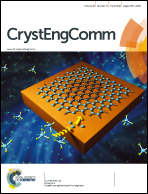Ce doping influence on the magnetic phase transition in In2S3:Ce nanoparticles
Abstract
The classical thermally driven transition from supermagnetic to blocked supermagnetic and quantum phase transition from magnetic long-range order to quantum superparamagnetic state have been observed in ultrasmall In2S3:Ce diluted magnetic semiconductors (DMSs). The In2S3:Ce nanoparticles (5–6 nm) were synthesized by a facile gas–liquid phase chemical deposition process using Ce(COOCH3)3, In(COOCH3)3 and H2S as source materials. X-ray diffraction (XRD), X-ray photoelectron spectroscopy (XPS) and high resolution transmission electron microscopy (HRTEM) were used to characterize the structure, components, morphology and size. Photoluminescence emission spectroscopy (PL) demonstrates that the luminescence quantum efficiency increases with Ce addition and indicates the existence of Ce atoms in the structure. The magnetic properties reflect a strong f–f exchange interaction between the Ce ions. The Ce doped In2S3 nanoparticles are shown to exhibit a higher blocking temperature from superparamagnetic to magnetic long-range order state, and even show room-temperature ferromagnetism. The larger ionic radius of Ce results in a larger influence on carrier concentration, affecting the blocking temperature of the magnetic phase transition.


 Please wait while we load your content...
Please wait while we load your content...